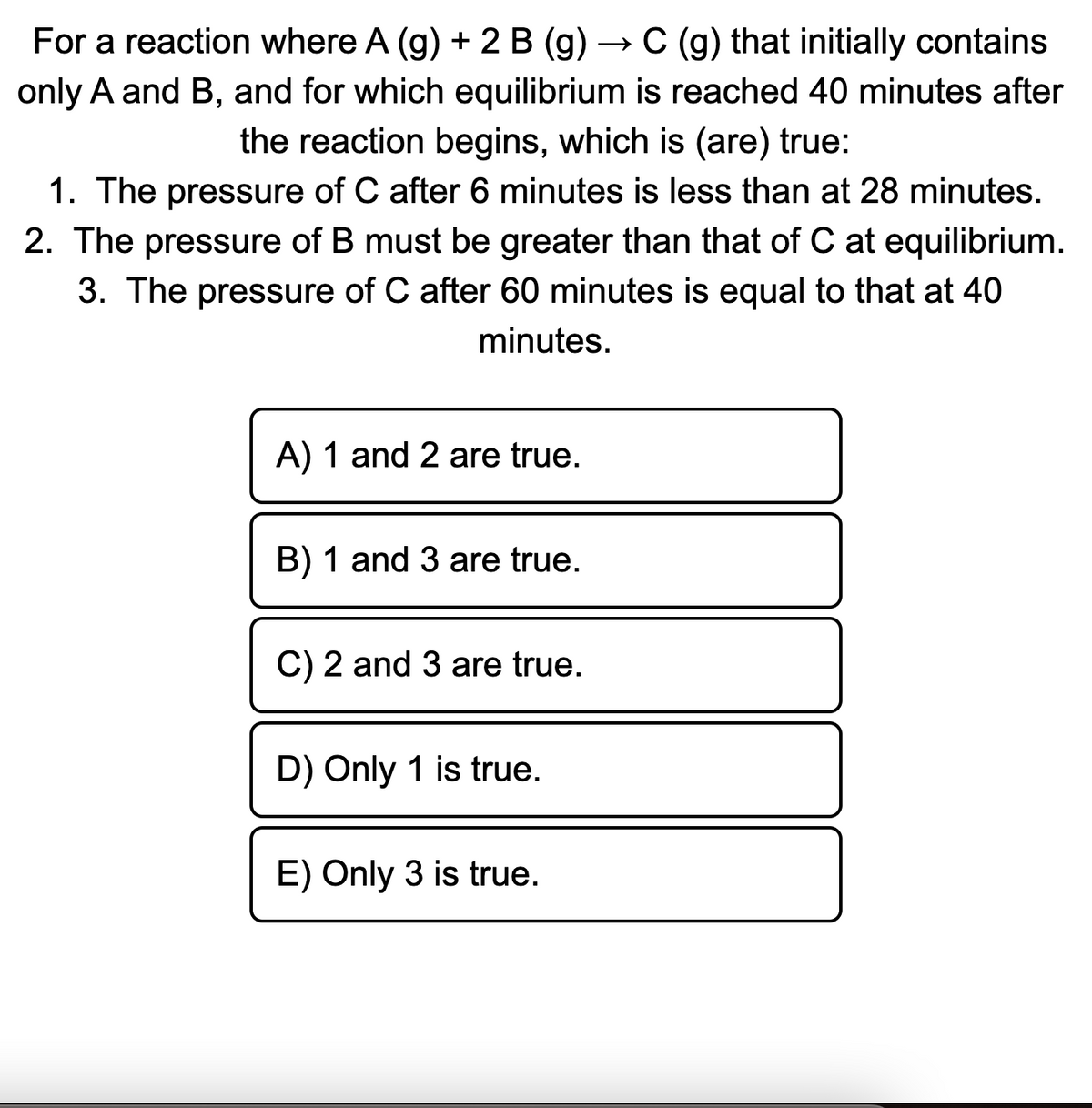For a reaction where A (g) + 2 B (g) → C (g) that initially contains only A and B, and for which equilibrium is reached 40 minutes after the reaction begins, which is (are) true: 1. The pressure of C after 6 minutes is less than at 28 minutes. 2. The pressure of B must be greater than that of C at equilibrium. 3. The pressure of C after 60 minutes is equal to that at 40 minutes. A) 1 and 2 are true. B) 1 and 3 are true. C) 2 and 3 are true. D) Only 1 is true. E) Only 3 is true.
For a reaction where A (g) + 2 B (g) → C (g) that initially contains only A and B, and for which equilibrium is reached 40 minutes after the reaction begins, which is (are) true: 1. The pressure of C after 6 minutes is less than at 28 minutes. 2. The pressure of B must be greater than that of C at equilibrium. 3. The pressure of C after 60 minutes is equal to that at 40 minutes. A) 1 and 2 are true. B) 1 and 3 are true. C) 2 and 3 are true. D) Only 1 is true. E) Only 3 is true.
Chemistry: Principles and Reactions
8th Edition
ISBN:9781305079373
Author:William L. Masterton, Cecile N. Hurley
Publisher:William L. Masterton, Cecile N. Hurley
Chapter12: Gaseous Chemical Equilibrium
Section: Chapter Questions
Problem 82QAP: A student studies the equilibrium I2(g)2I(g)at a high temperature. She finds that the total pressure...
Related questions
Question

Transcribed Image Text:For a reaction where A (g) + 2 B (g) → C (g) that initially contains
only A and B, and for which equilibrium is reached 40 minutes after
the reaction begins, which is (are) true:
1. The pressure of C after 6 minutes is less than at 28 minutes.
2. The pressure of B must be greater than that of C at equilibrium.
3. The pressure of C after 60 minutes is equal to that at 40
minutes.
A) 1 and 2 are true.
B) 1 and 3 are true.
C) 2 and 3 are true.
D) Only 1 is true.
E) Only 3 is true.
Expert Solution
This question has been solved!
Explore an expertly crafted, step-by-step solution for a thorough understanding of key concepts.
This is a popular solution!
Trending now
This is a popular solution!
Step by step
Solved in 3 steps

Knowledge Booster
Learn more about
Need a deep-dive on the concept behind this application? Look no further. Learn more about this topic, chemistry and related others by exploring similar questions and additional content below.Recommended textbooks for you

Chemistry: Principles and Reactions
Chemistry
ISBN:
9781305079373
Author:
William L. Masterton, Cecile N. Hurley
Publisher:
Cengage Learning

Chemistry by OpenStax (2015-05-04)
Chemistry
ISBN:
9781938168390
Author:
Klaus Theopold, Richard H Langley, Paul Flowers, William R. Robinson, Mark Blaser
Publisher:
OpenStax

Chemistry & Chemical Reactivity
Chemistry
ISBN:
9781133949640
Author:
John C. Kotz, Paul M. Treichel, John Townsend, David Treichel
Publisher:
Cengage Learning

Chemistry: Principles and Reactions
Chemistry
ISBN:
9781305079373
Author:
William L. Masterton, Cecile N. Hurley
Publisher:
Cengage Learning

Chemistry by OpenStax (2015-05-04)
Chemistry
ISBN:
9781938168390
Author:
Klaus Theopold, Richard H Langley, Paul Flowers, William R. Robinson, Mark Blaser
Publisher:
OpenStax

Chemistry & Chemical Reactivity
Chemistry
ISBN:
9781133949640
Author:
John C. Kotz, Paul M. Treichel, John Townsend, David Treichel
Publisher:
Cengage Learning

Chemistry & Chemical Reactivity
Chemistry
ISBN:
9781337399074
Author:
John C. Kotz, Paul M. Treichel, John Townsend, David Treichel
Publisher:
Cengage Learning

Chemistry: An Atoms First Approach
Chemistry
ISBN:
9781305079243
Author:
Steven S. Zumdahl, Susan A. Zumdahl
Publisher:
Cengage Learning

General Chemistry - Standalone book (MindTap Cour…
Chemistry
ISBN:
9781305580343
Author:
Steven D. Gammon, Ebbing, Darrell Ebbing, Steven D., Darrell; Gammon, Darrell Ebbing; Steven D. Gammon, Darrell D.; Gammon, Ebbing; Steven D. Gammon; Darrell
Publisher:
Cengage Learning